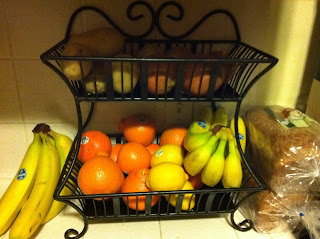Of all my budget categories, there is one that continuously taunts me. Almost like fourth graders on a playground, but not quite because I'm not exactly in the fourth grade and it's my budget - not a fourth grader - doing the taunting. So I guess not really anything like a fourth grader. Nevertheless, it taunts.
I'm referring to my grocery budget.
When it comes to cooking, I waffle between being incredibly lazy (cereal anyone?) to unlocking my inner Cat Cora. But most of my success at dinnertime has nearly everything to do with how prepared my kitchen is to accept the cooking challenge, and that same preparation (i.e. menu planning) also helps me save money.
I started menu planning last March after my husband and I paid off our debt. I kept reading about how menu planning saves money, but it didn't make sense until I tried it out. Ironically, when you're not running to the store 4 times a week, you don't spend money at the store 4 times a week. I'm still not perfect, but I am much, much better.
My basic formula is this:
1. I open allrecipes.com, foodnetwork.com, and marthastewart.com. I search for recipes that use overlapping ingredients. Well, and that sound yummy. I add the dinner menu to my list, then print out the appropriate recipes.
2. I create a shopping list based on the ingredients I don't have. Instead of writing "potatoes", I'm very specific. I write "3 red potatoes" if that's how many my recipe calls for. The only thing I buy in non-specific portions are the various fruits my kids eat because they ALWAYS get consumed before the fruit goes bad. I also stay away from buying items simply because "they're on sale." For instance, I don't purchase dressing that is on sale simply because it's on sale. If we don't need it in the next week, I don't buy it (there are some exceptions to this rule, especially regarding certain meat).
3. I grab my reusable bags and go shopping (Sprouts and Target both knock off 5 cents per reusable bag). I visit Sprouts for my produce and meat, Costco for bulk items (chicken stock, organic eggs), Target for pantry items, and Trader Joe's for the specialty stuff (frozen fruit for smoothies, buttermilk, etc).
4. When I get home, I start putting the food away, one shelf at a time. I first clear the shelf, wipe it down, then put the food away. That way I am reminded exactly what I have in my fridge and where it went.
My husband is a big fan of leftovers (yay!) so he often eats those for lunch. I also make sure to have sandwich fixings or something quick (see: pizza) to throw in the oven on those super busy days.
One of these days I'll be more organized and have a folder of past (successful) recipes to pull from, but for now I still just think of something that I feel like making and start my search from there.
Other budget tips:
-We actually NEVER buy juice. Other than water, the only beverage my kids really drink are smoothies, and that usually makes up half their meal.
-If I have leftover produce from the week before, I try to find recipes that incorporate them. For instance, I know we won't make it through the container of tomatoes this week, so next week will most likely include spaghetti. =)
-Buy in bulk - but only if you'll use it! It is WAY more cost-effective for me to purchase flour, chicken stock, butter and eggs at Costco. However, our family can't make it through their huge bag of asparagus or cucumbers in time for it to be a worthwhile purchase.
If you haven't tried menu planning before, I really encourage you to give it a try. It really makes dinner-making WAY more doable. If you need recipe ideas or any help, please feel free to email me. There are also tons of websites dedicated to menu planning. And for the simplest start for the non-cook, check out e-mealz.com. It costs about $5 a month, but definitely worth it if you're clueless in the kitchen! =)














